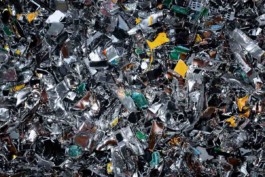
Digital Waste and the Anthropocene
This is the site of the automation revolution. Away from prying eyes, huge swathes of land house giant data centres. They not only store the digital aspects of our daily lives, but also process them to ‘optimise’ human existence, at an untold cost to the environment, and to other species.
While the invisible data cloud seems intangible, its physical reality creates numerous issues with regards to land usage and energy consumption, and these are growing. Algorithms help us track and make use of the ever increasing accumulated digital knowledge known as big data, yet the companies that are collecting these huge datasets often struggle with a problem of quality vs. quantity. Rather than seeking to identify unnecessary noise and waste, they compulsively hoard, knowing that additional data storage bears little marginal cost, with the hope of converting waste into insights.
Over time, without proper care, the data grows duplicitous, erroneous and declines in quality, ceasing to be useful and superseded by new information. This ‘dirty’ data is costly not only for the companies but also for our ecosystems. Today global data centers consume more energy than the entire UK, and by 2025 they will account for more than 20% of our Global Energy usage. With this growing demand for energy comes yet more CO2 emissions, our addiction to data locking us into a new consumption cycle, driving us towards a future of ‘data warming’.
It certainly is important that we start paying attention to our attitude towards data and in particular this unusable information, to either establish new practices that explore circular economy processes, or look into new regulations regarding the production, usage and storage of data. To get out of this strange loop of consumption, production, waste and destruction, a cycle that harms and violates nature, we might turn to nature for inspiration, and start looking to incorporate biology back into our systems. Scientists from the University of Washington are working with Microsoft Research to explore the feasibility of large-scale alternative data storage, namely in synthetic DNA.
DNA is the oldest storage device in the world, and is one of the most promising ways of solving our data management problems. This new technology has the potential to store all of the world’s data in just 1 kg of DNA. It can last a remarkably long time in the right conditions and the format would never become obsolete. Most tantalizing of all is the possibility that we might be able to genetically modify organisms which sustain themselves such as bacteria, utilising ‘blank space’ in the DNA structures to archive data.
But this presents new questions. Could a GMO really become our future solution for data warming? What if we use the DNA of a larger living organism, such as a plant, to store some of our information? Plants are generous and life-giving organisms, providing habitats, producing food and creating oxygen. They are also extremely mysterious organisms, holding many secrets and possessing unimaginable qualities and they would potentially be an excellent candidate to become a new living hardware.
While they may seem simple, in fact plants have the largest known genome of any species on Earth. The largest, Paris Japonica, has 149 billion base pairs - 50x the size of the human genome. Thus despite their apparent modesty, their DNA structure holds significantly more information than that of humans. Different methods could be used, and indeed have already been devised, to insert and read back the data from a plant. All of them require time and special conditions which makes plant-based data storage a good way to store data that doesn’t have to be accessed on a daily basis.
Each time we introduce technology, and particularly in this case, we ought to consider a lot of speculative ethical questions. What is the impact of the new data on the plant? Imagine the plant pollinates, how could data privacy issues be impacted? What if the plant dies, should the data die within the plant? Can you replant your data? These qualities might change our interactions with data, transforming a relationship that is remote and technical, into something intimate and alive, through living and ‘breathing’ organisms that become the hosts of the digital aspects of our lives.
The idea of exchanging the enormous, nonhuman, cold data farms which inhabit industrial wastelands with reforested space that produces life-giving oxygen seems tempting enough to start looking into finding ethical and efficient ways to make this a reality. Creating a sustainable way to archive data, even data that does not have immediate present value could be vital to help develop new ideas, and biological data storage explored within a conscious and critical context, presents us with an opportunity to do this respecting life-based design principles to create a harmonious and elegant outcome.